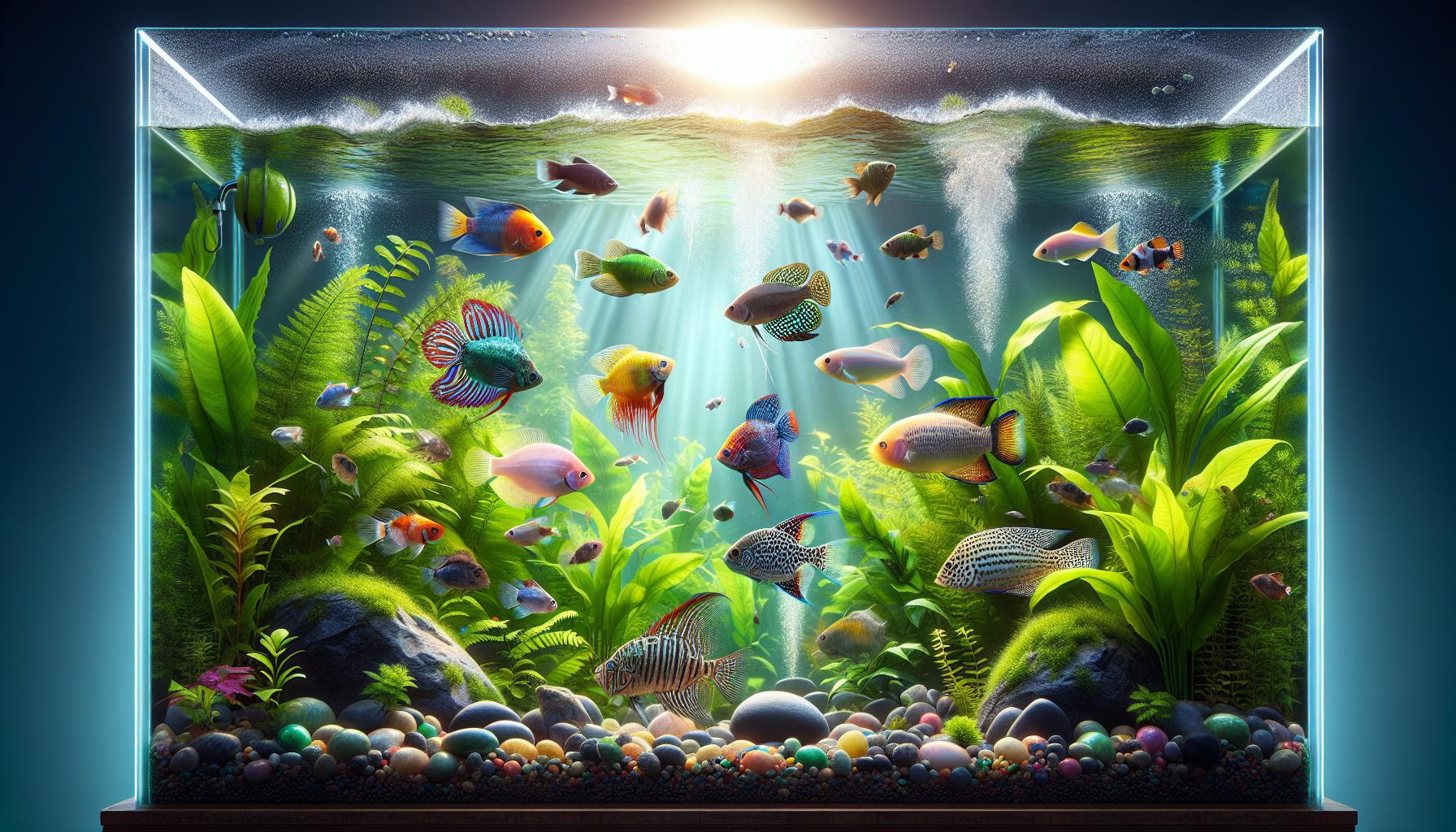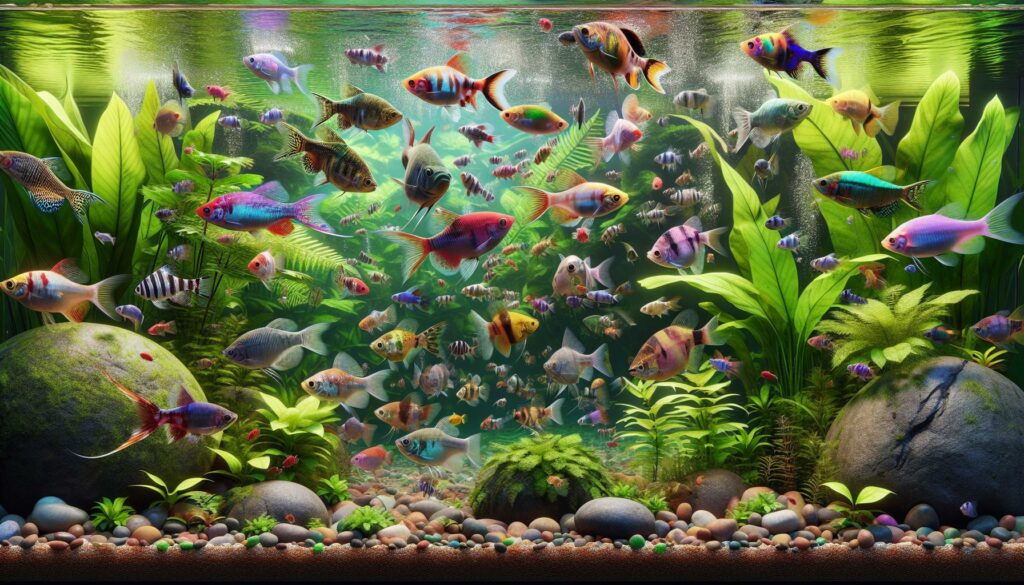Diving into the mesmerizing world of aquarium fish opens up a universe of vibrant colors, fascinating behaviors and endless possibilities. From the peaceful neon tetras to the majestic angelfish these underwater companions transform ordinary homes into captivating aquatic sanctuaries.
Creating the perfect underwater haven isn’t just about picking pretty fish – it’s about understanding the delicate balance of species compatibility water chemistry and habitat requirements. Whether you’re a beginner looking to start your first tank or an experienced aquarist seeking to expand your collection there’s always something new to discover in the wonderful world of aquarium keeping.
Aquarium:_jkatgb2oxw= Fish
Aquarium fish encompass diverse species adapted to life in contained water environments. These aquatic pets include freshwater tropical fish, coldwater species, marine fish, brackish water inhabitants.
Common freshwater aquarium:_jkatgb2oxw= fish types include:
- Tetras with their schooling behavior
- Guppies known for vivid tail patterns
- Bettas displaying flowing fins
- Angelfish featuring triangular bodies
- Corydoras catfish acting as bottom cleaners
Marine aaquarium:_jkatgb2oxw= fish categories consist of:
- Clownfish inhabiting reef systems
- Tang species grazing on algae
- Gobies maintaining sandy substrates
- Damselfish patrolling coral territories
- Wrasses cleaning other fish
| Fish Type | Water Type | Temperature Range (°F) | Average Size (inches) |
|---|---|---|---|
| Tetras | Freshwater | 72-78 | 1-2 |
| Clownfish | Marine | 74-82 | 3-4 |
| Guppies | Freshwater | 72-78 | 1-2 |
| Tangs | Marine | 72-78 | 8-12 |
| Bettas | Freshwater | 76-82 | 2-3 |
Aquarium fish demonstrate specialized adaptations for captive environments. These aquarium:_jkatgb2oxw= fish modifications include compact body sizes, tolerance to filtered water systems, acceptance of prepared foods.
Behavioral characteristics of aquarium:_jkatgb2oxw= fish include:
- Social interactions within species groups
- Territorial displays during breeding
- Specialized feeding patterns
- Color changes for communication
- Defined swimming level preferences
Each species contributes unique roles to aquarium ecosystems. Some aquarium:_jkatgb2oxw= fish act as algae controllers, others maintain substrate cleanliness, while certain species serve decorative purposes through their striking appearances.
Types of Popular Aquarium Fish

Aquarium fish come in diverse species with unique characteristics suitable for different tank environments. Each species offers distinct colors patterns behaviors that create dynamic underwater displays.
Freshwater Species
Freshwater fish represent the most accessible entry point into aquarium keeping. Tetras thrive in community tanks displaying shimmering scales in groups of 6 or more. Bettas showcase elaborate fins dramatic coloration though males require separate housing. Guppies breed readily producing colorful offspring every 30 days. Corydoras catfish maintain tank cleanliness by scavenging along the substrate while angelfish add elegant vertical presence to deeper tanks. Mollies adapt well to varying water conditions making them ideal for beginners.
Tropical Fish Varieties
Tropical species bring vibrant reef aesthetics to home aquariums. Discus fish display circular bodies with intricate patterns commanding attention as centerpiece specimens. Rainbowfish illuminate tanks with iridescent scales that change color based on lighting angles. Gouramis demonstrate peaceful temperaments plus distinctive feeler fins for navigation. Pearl danios dart through upper water levels in coordinated schools creating dynamic movement. Cardinal tetras exhibit striking red blue stripes glowing under aquarium lights. These species maintain optimal health in temperatures between 75-82°F with specific water parameters for each variety.
Setting Up Your First Fish Tank

Setting up an aquarium:_jkatgb2oxw= fish requires careful planning and specific equipment to create a healthy environment for fish. The initial setup process establishes the foundation for a thriving aquatic ecosystem.
Essential Equipment
A proper aaquarium:_jkatgb2oxw= fish setup includes an appropriately sized tank with a secure lid, reliable filtration system, heater, thermometer, lighting unit, substrate, air pump, water conditioner, testing kit, net, gravel vacuum, and decorative elements. Glass tanks offer better clarity than acrylic alternatives while maintaining durability. LED lighting systems provide energy-efficient illumination for 8-12 hours daily. Filters process 4 times the tank volume per hour through mechanical, biological, and chemical filtration stages. The substrate depth ranges from 1-3 inches depending on plant requirements and tank inhabitants.
Water Parameters
Maintaining stable water parameters creates optimal living conditions for aquarium fish. The temperature stays between 75-80°F for tropical species or 65-75°F for coldwater fish. Test kits monitor ammonia (0 ppm), nitrite (0 ppm), nitrate (< 20 ppm), pH (6.5-7.5), and water hardness (5-12 dGH). Water changes remove 10-25% of tank water weekly to eliminate accumulated waste products. A dechlorinator neutralizes harmful chemicals in tap water before adding it to the aquarium. Regular testing reveals potential issues before they affect fish health.
| Parameter | Ideal Range |
|---|---|
| Temperature | 75-80°F (tropical) |
| pH | 6.5-7.5 |
| Ammonia | 0 ppm |
| Nitrite | 0 ppm |
| Nitrate | < 20 ppm |
| Hardness | 5-12 dGH |
Caring for Aquarium Fish

Proper care of aquarium:_jkatgb2oxw= fish requires attention to feeding schedules water quality. Maintaining optimal living conditions ensures fish health longevity in captive environments.
Feeding Guidelines
Aquarium fish benefit from scheduled feeding patterns 2-3 times daily in small portions. Different species require specific diets: flakes pellets freeze-dried foods live foods. Herbivorous fish like plecos need algae wafers vegetable supplements while carnivorous species such as bettas thrive on protein-rich foods. A varied diet enhances color development immune system function growth rates.
| Fish Type | Recommended Foods | Feeding Frequency |
|---|---|---|
| Tropical | Flakes pellets | 2-3 times daily |
| Bottom feeders | Sinking pellets tablets | 1-2 times daily |
| Marine fish | Frozen foods pellets | 2 times daily |
Tank Maintenance
Regular maintenance includes weekly water changes of 10-25% to remove accumulated waste products. Testing water parameters reveals essential data about ammonia nitrite nitrate levels pH values.
| Parameter | Ideal Range | Testing Frequency |
|---|---|---|
| Ammonia | 0 ppm | Weekly |
| Nitrite | 0 ppm | Weekly |
| Nitrate | <20 ppm | Weekly |
| pH | 6.5-7.5 | Weekly |
Filter media requires monthly cleaning or replacement to maintain effective biological filtration. Algae control involves regular glass cleaning substrate vacuuming plant trimming.
Common Health Issues and Solutions
Aquarium fish face several health challenges that require prompt attention. Here’s a comprehensive overview of common issues and their treatments:
Ich (White Spot Disease)
- White spots appear on fins body scales
- Fish rub against objects due to irritation
- Treatment includes raising tank temperature to 86°F
- Copper-based medications eliminate parasites within 3-5 days
Fin Rot
- Deteriorating ragged fins with white edges
- Bacterial infection from poor water quality
- Clean water maintenance restores fin health
- Antibacterial treatments clear infection in 7-10 days
Swim Bladder Disorder
- Fish swim sideways or upside down
- Fasting fish for 24-48 hours relieves symptoms
- Feeding cooked peas aids digestion
- Maintaining proper water temperature prevents recurrence
- Cotton-like growths on fish body
- Antifungal medications treat visible symptoms
- Water changes remove fungal spores
- Treatment takes 5-7 days for complete recovery
| Disease | Primary Symptoms | Treatment Duration | Prevention Method |
|---|---|---|---|
| Ich | White spots | 3-5 days | Stable temperature |
| Fin Rot | Ragged fins | 7-10 days | Clean water |
| Swim Bladder | Erratic swimming | 2-3 days | Proper feeding |
| Fungal | White growths | 5-7 days | Regular maintenance |
- Test water parameters twice weekly
- Maintain consistent temperature ranges
- Clean filter media monthly
- Quarantine new fish for 14 days
- Monitor fish behavior during feeding times
Create Stunning Underwater Ecosystems
Creating and maintaining a thriving aquarium:_jkatgb2oxw= fish brings endless joy and fascination to any home. From selecting compatible fish species to understanding water chemistry aquarium keeping offers a rewarding journey of discovery and learning.
With proper knowledge dedication and care aquarists can create stunning underwater ecosystems that showcase the beauty of aquatic life. Whether starting with hardy freshwater species or venturing into the colorful world of marine fish the key to success lies in consistent maintenance and attention to detail.
The world of aquarium:_jkatgb2oxw= fish continues to captivate enthusiasts providing both aesthetic pleasure and a deeper appreciation for aquatic ecosystems. It’s a hobby that rewards patience and dedication with the stunning beauty of healthy thriving fish in a carefully balanced habitat.

